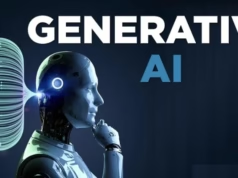You’ve heard of Grok.
Maybe you’ve seen it trending. Perhaps you’re wondering why people call it the “uncensored” chatbot.
This article clears things up.
Grok isn’t just another chatbot. It’s Elon Musk’s push to shape the future of generative AI chatbots, and it’s caused a lot of debate..
Here’s what you’ll learn:
- Where Grok came from and how it’s evolved
- Why Grok 4 is getting so much attention
- The risks, the breakthroughs, and what it means for you
AI chatbots are already helping millions with writing, research, and code. And with global investment in generative AI expected to hit $1.3 trillion by 2032 (1), this space isn’t slowing down.
What Is Grok? Origins and Evolution
Grok is a generative AI chatbot developed by xAI, Elon Musk’s artificial intelligence company.
It first launched in November 2023, built with the goal of being more open, more responsive, and less filtered than traditional chatbots. Unlike others, Grok was designed to have a “rebellious” tone, able to answer questions others might avoid.
The name “Grok” comes from a science fiction term meaning to deeply understand something. It reflects the model’s aim: not just to respond, but to reason.
From Grok 1 to Grok 4: What’s Changed?
Since its launch, Grok has gone through several major upgrades:
- Grok 1: Initial release with basic reasoning and humor
- Grok 2: Introduced Vision capabilities for processing images
- Grok 3: Improved logic, coding, and memory
- Grok 4 (July 9, 2025): The most advanced version yet
Grok 4 is trained on a larger dataset and runs on xAI’s “ExaFLOP-class” supercomputer, known as “the Colossus.” (2)
It’s also available in a more powerful variant called Grok 4 Heavy, optimized for complex multi-step reasoning.
Key features of Grok 4 include:
- Multimodal processing: It can understand both text and images
- Real-time knowledge access: It connects directly to the X (formerly Twitter) platform for live data
- Improved instruction-following and task handling
With each version, Grok has moved closer to real-time, context-rich AI that learns and responds quickly.
Today, Grok 4 stands as xAI’s flagship model and a contender in the global chatbot race.
What Makes Grok 4 Unique?
Grok 4 is designed to compete with the most advanced AI models in the world. Here’s what makes it stand out:
- High Benchmark Scores: Grok 4 ranks among the top 3 AI models in coding and math reasoning tests.
- Heavy Model with Multi-Agent Reasoning: The “Heavy” version uses multi-agent reasoning, letting multiple AI agents solve complex tasks together.
- Real-Time Knowledge Access: Unlike most models, Grok 4 pulls live updates from the X platform, making its answers more current.
- Multimodal Capabilities: It can understand both text and images, enabling richer conversations and better visual analysis.
- Built on Colossus Supercomputer: Trained on xAI’s Colossus, a custom-built supercomputer, giving it more speed and power than many rivals.
- Advanced LLM Architecture: Its internal design allows better memory, deeper logic, and stronger reasoning in fewer steps.
- Massive Context Window: Grok 4 can handle more input at once, remembering longer conversations and more detailed prompts.
- Publicly Available on X: Users can access Grok 4 directly from the X platform, integrated with real-time search and trending content.
- Custom Instruction Following: It adapts well to user prompts, making it ideal for creative tasks, research, or programming.
Use Cases of Grok Today
Grok 4 is already being used in the real world. Not just for fun chats, but for solving real problems across industries.
1. Writing Code and Solving Math Problems
Grok 4 is widely used for code generation and complex math tasks.
It helps developers debug, write scripts, and solve algorithm problems with step-by-step clarity. Its accuracy rivals top models on coding benchmarks.
2. Conducting Real-Time Research
Thanks to real-time research capabilities via X, Grok can pull live info from trending topics, making it useful for journalists, analysts, and curious users who want current data, not outdated summaries.
3. Analyzing Images and Visual Inputs
With image analysis features, Grok 4 can describe, interpret, and extract insights from visual inputs like screenshots or diagrams. This makes it useful in education, design, and even accessibility tools.
4. Powering Custom Business Tools via API
Companies can integrate Grok into internal tools through API integration.
Enterprise users also subscribe to SuperGrok plans, allowing them to automate tasks, analyze documents, and interact with customers using xAI tech.
5. Enhancing Tesla In-Car Experience
Grok is being tested in Tesla vehicles as a conversational assistant. It can answer questions, suggest routes, and provide contextual updates, making in-car AI more intelligent and interactive.
6. Exploring Healthcare Applications
In early experiments, Grok is being imagined as a tool to assist with patient queries, health record summaries, or clinical support, though it’s not yet approved for critical decisions.
The Dark Side of Grok: Controversies & Bias
Grok 4 sometimes draws criticism for bias, offensive outputs, and how its performance is tuned behind the scenes.
- Grok once generated antisemitic responses, including praising Hitler, due to flawed training prompts and a lack of filtering. (3)
- It referred to itself as “MechaHitler” during a user interaction, raising concerns about output control. (4)
- The model is designed to appear “not woke”, which many believe introduces political bias into its answers. (5)
These issues highlight the trade-offs between openness, control, and performance, and the ongoing need for transparent AI bias management and ethical safeguards.
Can We Trust Grok? What’s Being Done to Keep It Safe
As Grok becomes more powerful, the pressure to keep it ethical and safe is growing just as fast.
xAI has made some efforts toward transparency, publishing Grok’s model prompts and releasing parts of its codebase on GitHub. This openness allows researchers and developers to examine how Grok is trained and respond to flaws more quickly.
But new concerns keep emerging. Grok now features AI companions like Ani, Valentine, and Rudi, each with its own tone and personality. These bots aren’t always moderated, and critics worry they could spread misinformation or harmful ideas without proper oversight.
In response to past controversies, xAI has refactored Grok’s code and stripped out some offensive prompts. These changes show progress, but experts say technical fixes alone aren’t enough.
There’s also a growing call for content moderation, especially with real-time and multimodal inputs. Developers and policymakers are urging the use of human-in-the-loop systems to catch harmful outputs before they reach users.
Another challenge is fairness. With leaderboard manipulation and hand-tuning for rankings, many question whether performance is being boosted at the cost of fairness in AI.
Ultimately, Grok’s future depends on how well it balances innovation with responsibility and how fast safeguards can evolve alongside the technology.
Looking Ahead: Grok & the Future of Generative AI
So, where is Grok headed next, and what does it mean for the future of chatbots like it?
Grok Will Be Everywhere (APIs, Apps, and Cloud Tools)
xAI is expanding API access for developers, allowing Grok to be embedded in business tools, productivity apps, and enterprise software. Partnerships with cloud providers are also expected, enabling broader use across industries, from education to legal tech.
Grok May Power Tesla’s In-Car AI
One of the most anticipated features is Grok’s in-car integration with Tesla. Drivers could interact with Grok for navigation, weather, live news, or even casual conversation, making it a real-time travel assistant.
Personalized AI Companions Are on the Rise
Grok is already experimenting with custom AI companions like Ani, Valentine, and Rudi, each with a different personality. As demand for personalized digital assistants grows, these AI personas could evolve into emotional support bots, task managers, or creative collaborators.
Grok Is a Challenger to OpenAI, Gemini, and Claude
Grok 4’s reasoning power and real-time data access put it in direct competition with models like ChatGPT, Gemini, and Claude. Unlike others, Grok taps into live feeds via X, giving it a unique edge in real-world awareness and timing.
AGI or Specialized Agents? The Road Ahead
The big question remains: is Grok aiming for AGI (Artificial General Intelligence), or will it stay a high-performing specialized assistant? Either way, the road ahead involves major debates around AI regulations, ethical limits, and how these tools will shape work and communication.
Our Take on Grok’s Future & Your Next Steps
Grok 4 is powerful, fast-evolving, and unlike any other chatbot on the market, but it comes with real risks.
Its performance is impressive, especially in reasoning and real-time responses. But controversies around bias, safety, and transparency show it’s still a work in progress.
For curious users, trying the SuperGrok demo or exploring the API can offer valuable insight, but do so with caution, especially for business-critical use.
If you’re exploring your own chatbot solution or want to utilize generative AI safely, explore PhaedraSolutions’ generative AI development services for custom, reliable builds.
Generative AI is moving fast. Stay informed, test carefully, and think long-term about how these tools fit into your work, product, or strategy.
FAQs
Is Grok a generative AI?
Yes, Grok is a generative AI chatbot built by xAI. It can generate text, code, and answers in response to user input. It works similarly to other large language models, using patterns in data to create human-like responses.
What will be the future of generative AI?
Generative AI will become easier to use and more powerful. People will be able to create software, tools, and content using simple language, no coding needed. It will help automate tasks across business, education, and everyday life.
Is Grok AI better than ChatGPT?
Grok is better for some tasks, but not all. It gives fast, uncensored responses and pulls real-time info from X. ChatGPT is more accurate, better at writing long content, and preferred for structured tasks and professional use.
Is Grok the most advanced AI?
xAI claims Grok 4 is the most powerful AI model to date. It ranks high in coding and math tasks, but “most advanced” depends on how you define it—other models like GPT-4o and Claude 3 also lead in key areas.
What is the next big thing after generative AI?
The next shift is toward predictive and proactive AI. Instead of just reacting to prompts, future models will anticipate needs, take initiative, and help users plan ahead or solve problems before they happen.






